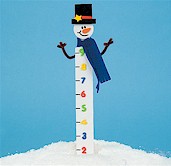Winter is here! Check out more winter weather themed citizen science projects at Scistarter.

You know what the atmosphere is. But have you heard of the cryosphere? No, it’s not a giant frozen ice-cream sphere, if that’s what you’re thinking. (That’s not what you were thinking? Never mind then!) The cryosphere, as Wikipedia most sagely teaches us, is the portion of the earth’s surface where water is in solid form (snow, ice, etc). Now, if you’re planning to drive home the day before Christmas, you will probably check out how much snow there is on the road on the weather channel or weather.com. These outlets get their snow depth data from government sources such as the NOAA’s National Weather Service or the Canadian Meteorological Centre (CMC). Apart from the safety of your road trip, there are many more uses to knowing what the snow cover will be such as predicting how much water rivers will receive from snowmelt. However, because the data comes from simulated models which use a combination of ground and satellite based snow measurements, their accuracy needs to be tested.
That is what the cryosphere research team at the University of Waterloo is trying to do with SnowTweets. And they want you to help them. Using just a ruler, a Twitter account and a few minutes of your time, you can contribute to cryosphere research. By crowdsourcing tweets about snow depths at various locations, the team hopes to collect frequent and high resolution data and match it with the meteorological data from NOAA & CMC. So how do you get started? Simple!

- Get a twitter account if you don’t already have one.
- Get a ruler or make your own (like the snowman themed one pictured on the right). Put on your winter gear!
- Step out and find one or more patches of undisturbed snow. If you can find a place away from buildings like a nearby park your measurement is more likely to be accurate. But if you can’t don’t worry. Your backyard will do just fine!
- Take a few depth measurements to see how it varies in different regions. Then, take the most representative measurement. For example if you measured 3”, 4”, 8”, 4”, 5”and 3” the most representative reading is probably 4” (The 8” would be an outlier). Remember that no snow measurements (i.e. 0 inches) are important to tweet out too!
- Tweet the measurement using the #snowtweets along with your zip code or latitude and longitude like this
#snowtweets <snow depth in cm, in or ft> at <zip code or latitude, longitude>
For example #snowtweets 5.0 in. at 20500 or #snowtweets 8.3 cm at 41.500, -120.750
If you’re outside North America, be sure to throw in your country name as well along with the zip code (e.g. #snowtweets 2 cm at 102-8166 Japan). Here’s my snowtweet
#snowtweets 6.5cm at 40.438,-79.920
— Arvind Suresh (@suresh_arvind) December 7, 2013
- Tweet many times a day as you want. Even better, if you’re going on a winter road trip, take a ruler, measure and tweet wherever you stop! Remember, more data = better!
- Give it a few minutes. The data will be processed by their automated system and will show up on Snowbird, the special visualization tool that the team has created for this project.
From early stage analyses of snowtweets data, the team has found that it matches pretty well with the data from simulations. Interestingly, the more tweets they get which are in regions close by to each other, the better the data matches. So the more you tweet, the more accurate their analyses will be! You can visit their website for more details on how to measure snow accurately and the SnowTweets team. Now get out there and write some #snowtweets! Image credits: NASA, www.makingfriends.com
Arvind Sureh is a graduate student in Cell Biology and Molecular Physiology at the University of Pittsburgh. He holds a Bachelor’s degree in Biotechnology from PSG College of Technology, India. For his thesis, he has been studying the molecular mechanisms behind uterine contraction during pregnancy. He is also an information addict, gobbling up everything he can find on and off the internet. He enjoys reading, teaching, talking and writing science, and following that interest led him to SciStarter. Outside the lab and the classroom, he can be found behind the viewfinder of his camera. www.suresharvind.com

